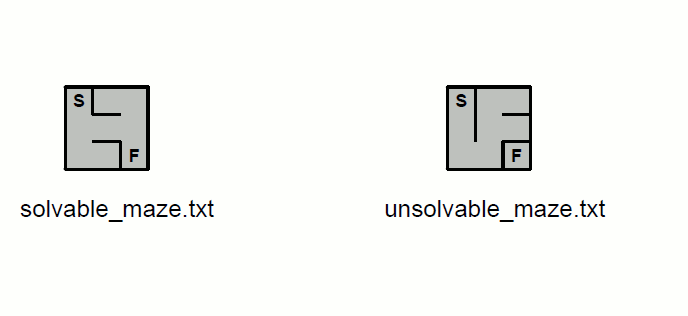Question
Use python3 to write a program that uses the Stack implementation given to you in stack.py to check if there is a solution to a
Use python3 to write a program that uses the Stack implementation given to you in stack.py to check if there is a solution to a maze. A simple maze implementation is given to you in maze.py. To solve a maze using the Stack, use the following algorithm: 1.Add the start square to the stack.
2.Repeat the following as long as the stack is not empty:
Pop a square off the stack (the current square)
If the current square is the finish square, the solution has been found
Otherwise, get the list of squares which can be moved to from the current square, and add them to the stack
Maze Description:
The maze.py file has two classes: Maze and MazeSquare.
You can create a new maze by calling the constructor: Maze(file_name), where file_name is the name of a file containing a maze.
You can get the start square of the maze by calling maze.get_start_square(). This method returns a MazeSquare.
To check if a square is the finish square, call maze.is_finish_square(square), where square is a MazeSquare.
The MazeSquare class represents a single square in the Maze. Calling maze_square.get_legal_moves()returns a list of MazeSquares that can be moved to.
Here is Stack.py
class Stack:
def __init__(self):
self.__items = []
def push(self, item):
self.__items.append(item)
def pop(self):
return self.__items.pop()
def peek(self):
return self.__items[len(self.__items)-1]
def is_empty(self):
return len(self.__items) == 0
def size(self):
return len(self.__items)
Here is maze.py:
# Classes for working with mazes
# This function takes a string as input, and returns a list of the ints in the
# string. This is used by the Maze constructor.
def parse_line(line):
line_contents = line.split()
i = 0
while i
line_contents[i] = int(line_contents[i])
i = i + 1
return line_contents
# Represents a Maze, with any number of squares.
class Maze:
# Creates a new maze:
def __init__(self, file_name):
file = open(file_name, "r")
maze_size = parse_line(file.readline())
self.__squares = []
for x in range(0, maze_size[0]):
self.__squares.append([0] * maze_size[1])
x = 0
while x
y = 0
while y
square = MazeSquare(x, y)
self.__squares[x][y] = square
y = y + 1
x = x + 1
start_location = parse_line(file.readline())
self.__start = self.__squares[start_location[0]][start_location[1]]
finish_location = parse_line(file.readline())
self.__finish = self.__squares[finish_location[0]][finish_location[1]]
for line in file:
legal_move = parse_line(line)
self.__squares[legal_move[0]][legal_move[1]].add_move(
self.__squares[legal_move[2]][legal_move[3]])
# Returns the start square of this maze:
def get_start_square(self):
return self.__start
# Returns True if the square is the finish square, and False otherwise:
def is_finish_square(self, square):
if square == self.__finish:
return True
else:
return False
# Represents a single square in a maze.
class MazeSquare:
def __init__(self, x, y):
self.__moves = []
self.__x = x
self.__y = y
def add_move(self, neighbor):
self.__moves.append(neighbor)
def get_legal_moves(self):
return self.__moves
def get_location(self):
return (self.__x, self.__y)
Here is solvable_maze.txt:
3 3
0 0
2 2
0 0 0 1
0 1 0 2
0 1 1 1
0 2 1 2
1 1 2 1
2 1 2 2
2 1 2 0
2 0 1 0
Here is unsovable_maze.txt
3 3
0 0
2 2
0 0 0 1
0 1 0 2
0 2 1 2
1 2 1 1
1 1 1 0
1 1 2 1
1 0 2 0


Step by Step Solution
There are 3 Steps involved in it
Step: 1

Get Instant Access to Expert-Tailored Solutions
See step-by-step solutions with expert insights and AI powered tools for academic success
Step: 2

Step: 3

Ace Your Homework with AI
Get the answers you need in no time with our AI-driven, step-by-step assistance
Get Started


